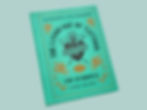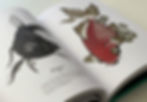The Language of Tattoos: 130 Symbols and What They Mean
- Kirstie
- Jan 4, 2023
- 5 min read
Updated: Sep 26, 2024
Book by Oliver Munden & Nick Schonberger
Published by Frances Lincoln

Book Review
This month we’re happy to be reviewing 'The Language of Tattoos, 130 Symbols and what they mean' by Oliver Munden & Nick Schonberger. Getting our hands on a copy of this beautifully illustrated hardback book has been a pleasure and the perfect end of year assignment.
The book explains the history, origins, and meanings of 130 well known symbols common in modern European/North American tattooing. Much loved and replicated symbols are brought to life through the skilfully rendered tattoo illustrations of artist Oliver Munden (Rock Steady Tattoo, Worthing U.K.), and the carefully researched accompanying text by writer/critic Nick Schonberger (whom you may be familiar with via publications ‘TTT: Tattoo’, and ‘The Graphic Art of Tattoo Lettering’).
The thoughtfully made depictions of each symbol are testament to Munden’s almost two decades worth of experience within the tattoo industry, and also working on commercial art projects ranging from murals, to tarot cards. Schonberger’s text explains the associated history, origins, and cultural significance, offering a brilliant insight into tattooing history and lore.
As tempting as it is to skip straight to skimming through the beautiful tattoo illustrations (done in american traditional, fineline, and traditional Japanese style), one of our favourite things that sets this book apart, is the introduction. Essential reading for any aspiring tattoo artist, apprentice, tattoo collector, and even worth a revisit for the most experienced artist - the introduction touches on the cultural appropriation of imagery. The introduction (and wider text) provides an often missed but essential honest insight into appropriation, cultural theft, and historic mis-use of symbols, which unfortunately cannot be separated from modern European/American tattooing. So often, the symbols derive from religion, cultural practice, ancient mythology, the horrors and hardships of military conflict and service, or imagery made for mass consumption for political or commercial purposes. Having a book which shines a light on the global influences behind symbols is a refreshing change in an industry which can sometimes be reluctant to pay mind to those difficult conversations.
The book also highlights the contributions of generations of tattooists who shared tattoo designs via post across cities and countries, and documented them at a time before information sharing was available at the click of a button. It reminded us of tattoo history legend of tattooists omitting certain details or lines from the symbols and designs they shared, as a test of skill for the recipient, or just to make sure their own version remained a better rendering! Variations abound, whether deliberate or accidental.
For Tattooists
As tattooists, the very least we can do is to understand and respect the symbols which due to their continued popularity still serve to pay our bills today. It’s good to view ourselves as custodians of tattoo history and lore, and to be interested and enthusiastic about passing on knowledge and awareness to others.
For those of us who had a tattoo apprenticeship, one of our first tasks was likely the painstaking copying of these symbols from the flash designs held by the studio. Back in the days where tattoo studios were covered with endless brightly coloured flash sheets to pick from, each studio needed corresponding 'linework versions', so that a line stencil could be made if a design was picked. Over the years, ready made linework sheets were sold alongside the colour ones. However the job of making stencils by hand in its most modern form has only relatively recently died out. It's only over the last 10-20 years that stencil machines have become the norm. So for many tattoo artists, the painstaking practice of copying out designs was in retrospect an invaluable part of the introduction to these symbols, and again another way that they took on slight changes and interpretations.
The most simple of symbols contain a wealth of information and learning for the apprentice. Understanding the importance of the amount of black used in a design. What order to apply linework, shading, and colour. Subtle shortcuts or tricks of light, shade and texture. Symbol replication taught us how to colour a rose, carefully observing gradation from black or colour to skin, with no two petals having solid colour bumping up against each other. How to curl a banner nicely around a heart, and the maddening task of equally spacing the letters of a name within. Looking for and recognising simple 's-shapes' upon which the flow of a design depends. Learning (and forgetting again) how many beads appear on a rosary and in what order. Accidentally using
the wrong colours/number of claws etc, as a blunder into the complex rules of Japanese Irezumi. Just some of the lessons hidden within these symbols. The next step for the tattoo artist is commonly to redraw symbols, which far from copying, more often leads to the discovery of your own style.
A digression
At its heart, tattooing has always been about subverting the status quo. But at its best, modern day re-interpretation and subversion of symbols is done with a good understanding of the roots, which is why this book is so important. While some might be so far removed they would’ve been unimaginable to previous generations of tattooists, we like to think they’d still appreciate the humour in them - especially where the tattoos are executed with technical skill.
One of our favourite things about modern tattooing is, when that same spirit of subversion is introspective. With western tattooists becoming increasingly self-aware, tattoos which poke fun at the pitfalls of mass western consumption and mindless replication of symbols pop up.
The ‘‘sucky panther’ tattoo sensation is a cherished example of this! The evolutionary path of 1930s/40s art deco influenced panther designs, suffering the occasional unfortunate loss of quality in their endless replication, spawning viral memes, and onslaught of endless deliberately bad, but technically well applied ‘sucky-looking’ panthers.
Or the long journey that starts with the Hindu and Buddhist spiritual geometry symbolic of and sacred to the mandala, travelling via mass consumption, disconnection and mispronunciation, onto the questionable nirvana that was an outbreak of ‘Nelson Mandela’ tattoos, deftly presenting Nelson from the Simpsons in glorious circular repetition.
Anyway, back to the book in question that sparked that little digression…
For Tattoo fans & collectors
The book is equally valuable for tattoo enthusiasts, tattoo fans and tattoo collectors. Who doesn't want to gain a deeper understanding of the designs that you're getting? Makes sense if they are going to be with you forever. Often tattoos can help to mark specific points in your life, honour a family member or occasion or provide inspiration for future goals.
And if you’re not into thinking that deeply about it, at the very least it’s good to know that you simply can't go wrong with a classic. These symbols have, and will stand the test of time. Solid choices that won’t quickly look out of fashion. You can be sure that people will be still getting rose tattoos in decades to come when your own rose tattoo is old and faded.
In a time of such rapid replication of visual content, some symbols gain a sort of ‘cult cool’ status, and can become separated from their origins. So recognising these symbols and their derivation is also a brilliant key to understanding wider iconography that you’ll inevitably come across in fashion, design & illustration, and online visuals.

Our Recommendation
‘The Language of Tattoos’ is the perfect gift for tattoo lovers of all kinds, whether you’re looking to flick through and gain inspiration from the beautiful tattoo illustrations, or looking for a deeper dive into tattoo symbology. We highly recommend getting a copy - it’s a must have for tattoo studio waiting rooms, and is now safely installed in ours.
With thanks to Oliver Munder and Nick Schonberger for the opportunity to review this book, and congratulations on documenting and illustrating such a large number of symbols - a real labour of love as the book shows.
Get your copy HERE
